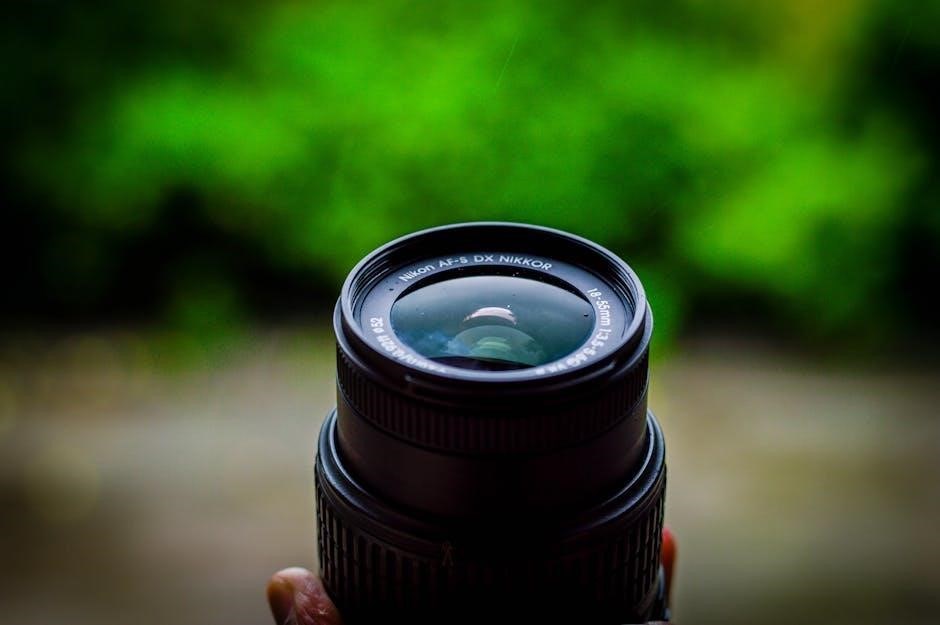The Nikon F manual is your essential guide to mastering this iconic 35mm film SLR camera. Designed for both enthusiasts and professionals, it provides detailed instructions on film loading, exposure settings, and camera maintenance. Whether you’re discovering the Nikon F for the first time or seeking to refine your skills, this manual is your key to unlocking its full creative potential and understanding its legendary design philosophy.
Overview of the Nikon F Camera
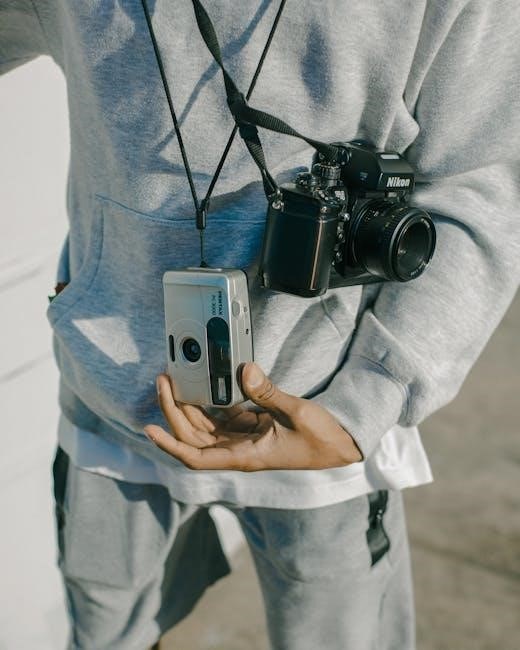
The Nikon F, introduced in 1959, was a groundbreaking 35mm single-lens reflex (SLR) camera that revolutionized photography. Designed for professionals, it featured interchangeable prism finders and lenses, setting a new standard in versatility. Its robust construction and intuitive design made it a favorite among photographers. The camera supported a wide range of interchangeable lenses, including the iconic Nikkor series, and offered manual controls for precise adjustments. With its durability and reliability, the Nikon F became a legendary tool for capturing high-quality images, solidifying Nikon’s reputation in the photography world.
Historical Significance of the Nikon F
The Nikon F, introduced in 1959, marked a pivotal moment in photography history. As Nikon’s first 35mm SLR, it established the company as a major player in the industry. Its innovative design, durability, and versatility set new standards for professional cameras. The Nikon F became a favorite among photojournalists and photographers worldwide, earning a reputation for reliability and performance. Its enduring popularity and influence solidified its place as a landmark camera in photographic history, paving the way for future Nikon models and shaping the evolution of SLR technology.
Key Features of the Nikon F
The Nikon F, introduced in 1959, was Nikon’s first 35mm SLR camera. It featured a robust, durable design with a fully mechanical shutter, offering speeds from 1/30 to 1/1000 of a second. The camera included interchangeable lenses, a removable prism finder, and flash synchronization; Its modular design allowed for customization, with optional metering systems and accessories. The Nikon F was renowned for its reliability and adaptability, making it a favorite among professionals. Its ergonomic design and intuitive controls set a new standard for SLR cameras, ensuring its enduring popularity and influence in photography.

Loading Film and Basic Operations
The Nikon F requires precise film loading and basic operational steps to ensure proper function. Always load film in a dark or shaded area to prevent exposure.
Step-by-Step Guide to Loading Film
To load film into the Nikon F, first, open the camera back by pulling the release latch. Ensure no old film remains before attaching the new roll to the spool. Thread the film leader through the guides and onto the take-up spool. Advance the film advance lever slightly to secure the leader. Close the camera back and advance the lever to the first stop to ensure proper tension. Set the film speed (ISO) on the lens. Finally, check the frame counter to confirm it starts at “0.” This process ensures your film is loaded correctly.
Understanding the Film Advance Lever
The film advance lever on the Nikon F is located on the top right side of the camera. It is used to advance the film to the next frame after taking a shot. To use it, pull the lever clockwise until it stops. This action cocks the shutter and advances the film. The lever should not be forced beyond its natural stop, as this could damage the mechanism. The lever also features a small notch for aligning with the camera’s body, ensuring proper advancement. Always ensure the lever is fully advanced before taking the next shot.
Setting the Shutter Speed and Aperture
The Nikon F allows manual control over shutter speed and aperture, giving photographers precise creative control. The shutter speed dial is located on the top of the camera, with settings from B (bulb) to 1/1000th of a second. The aperture is adjusted on the lens itself, with a ring that clicks into place at each f-stop. To set these, align the desired shutter speed and aperture to match your exposure needs. Use the exposure meter as a guide, ensuring the needle aligns with the center for proper exposure. Adjustments may require balancing one setting against the other to achieve the desired effect. Always test your settings for optimal results.
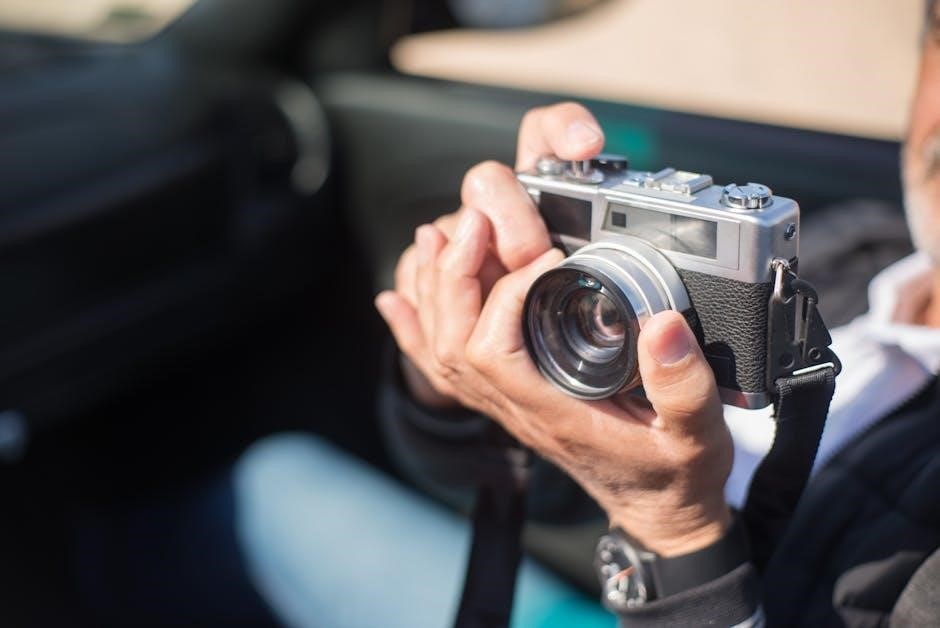
Exposure Settings and Metering
The Nikon F offers manual exposure settings and a built-in meter for precise control over aperture, shutter speed, and film speed, ensuring optimal results.
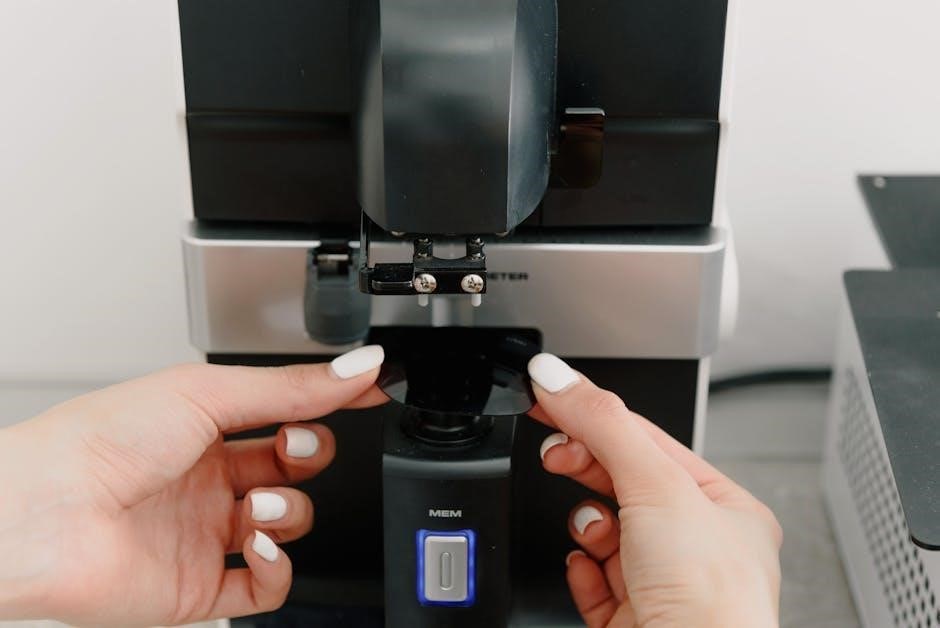
How to Set the Film Speed (ISO)
To set the film speed (ISO) on the Nikon F, locate the film speed ring on the lens. Rotate it to match the ISO of your film. Ensure the setting aligns with the marker for accuracy. This step is crucial for proper exposure metering. Always verify the ISO setting before shooting to avoid under or overexposure. The Nikon F’s manual design requires precise adjustments, making this step essential for achieving optimal results.
Using the Exposure Meter
The Nikon F features a built-in exposure meter to help achieve accurate exposures. Ensure the lens is set to its widest aperture (lowest f-stop) for metering. Point the camera at your subject, aligning the meter’s needle with the center mark. Adjust the aperture or shutter speed until the needles match. This system provides a reliable way to measure light and set proper exposure. Always meter in the same lighting conditions as your subject for consistent results. The meter is a valuable tool for optimizing your shots with the Nikon F.
Adjusting Shutter Speed and Aperture
Adjusting shutter speed and aperture on the Nikon F requires careful balance to achieve proper exposure. Shutter speed is set using the dial on the camera top, while aperture is adjusted on the lens. These settings control light entry and creative effects like motion blur or depth of field. For brighter conditions, use faster shutter speeds or smaller apertures. In low light, slower speeds or larger apertures are needed. Always check the exposure meter and adjust accordingly. Remember, changing one setting may require compensating with the other to maintain the desired exposure. Experiment to find the right balance for your shot.
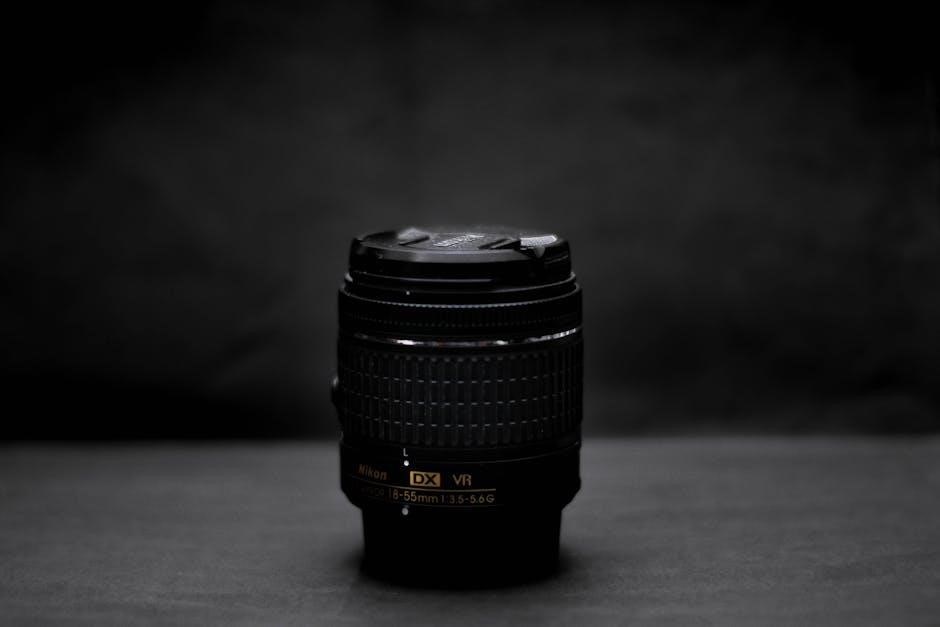
Lens and Accessories Compatibility
The Nikon F supports a broad spectrum of F-mount lenses and accessories, providing flexibility and compatibility for diverse photography applications and ensuring long-term system longevity.
Compatible Lenses for the Nikon F
The Nikon F is compatible with a wide range of F-mount lenses, including the legendary Nikkor series, which offers exceptional optical quality. Popular options include the 50mm f/1.4, 35mm f/2, and 105mm f/2.5, providing versatility for various photography styles. Telephoto and wide-angle lenses expand creative possibilities, while macro and zoom lenses cater to specialized needs. Although newer AF lenses are not fully compatible, they can still be used in manual focus mode, ensuring the Nikon F remains adaptable for modern photographers seeking a classic shooting experience.
Using the Self-Timer and Mirror Lock-Up
The Nikon F features a self-timer, ideal for minimizing camera shake in portraits or group shots. Set the timer by rotating the dial to the desired delay (typically 10 seconds). For mirror lock-up, raise the mirror manually to reduce vibrations during exposure, beneficial for long exposures or macro photography. Engage the mirror lock-up via the designated lever, then cock the shutter separately to capture the image. These features enhance stability and precision, ensuring sharper results in critical shooting scenarios.
Recommended Accessories
To enhance your Nikon F experience, consider essential accessories like high-quality Nikon F-mount lenses, ensuring optical excellence. A sturdy tripod is vital for stability, especially in low-light conditions. Filters, such as UV and neutral density, protect your lens and control light. The Nikon F’s interchangeable viewfinders allow customization for different shooting needs. Additionally, a reliable camera strap and protective case are must-haves for durability. For more insights, refer to Nikon’s official accessory guide or trusted photography resources.
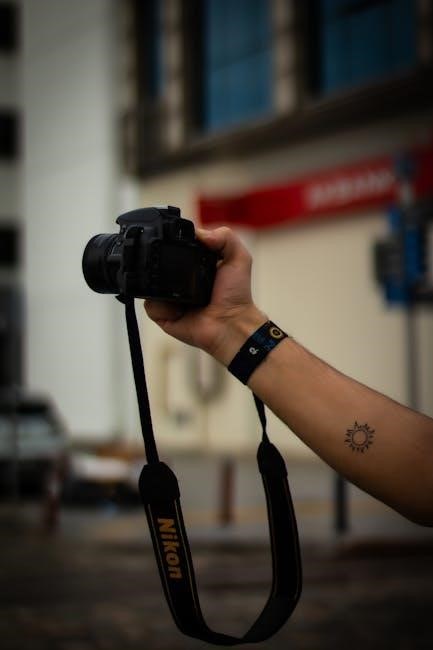
Maintenance and Care
Regularly service the Nikon F professionally to ensure optimal performance. Handle with care to prevent wear. Store in a cool, dry place to avoid damage. Use a soft, dry cloth for cleaning;
Cleaning the Lens and Mirror
Cleaning the lens and mirror is essential for maintaining image quality. Use a soft, dry microfiber cloth to gently wipe the lens, avoiding circular motions. For stubborn smudges, lightly dampen the cloth with distilled water, but never apply liquids directly to the lens. The mirror should be cleaned with compressed air or a specialized camera cleaning brush to remove dust particles. Avoid using tissue paper, as it may leave lint. Regular cleaning ensures sharp images and prevents damage to the optical surfaces. Always handle the lens with care to avoid scratches or fingerprints.
Regular Maintenance Tips
Regular maintenance ensures the Nikon F operates smoothly. Check for dust in the viewfinder and mirror box, using compressed air for cleaning. Lubricate moving parts like the film advance lever sparingly. Store the camera in a dry, cool place to prevent rust. Replace the light seals periodically to maintain proper film compartment sealing. Clean the shutter curtains if dirt is visible. Always use a lens cap when not shooting and inspect the camera body for wear. Regular checks help extend the camera’s lifespan and maintain its performance over time. Consistent upkeep ensures reliable functionality for years of photography.
Troubleshooting Common Issues
If the shutter fails to fire, ensure the battery is functional or replace it if necessary. A stuck film advance lever may indicate improper loading; rewind the film and try again. If light leaks occur, inspect the light seals for wear and replace them as needed. For a foggy viewfinder, allow the camera to air out in a dry environment. If the mirror sticks, clean the mirror box gently with a soft brush. Addressing these issues promptly ensures optimal performance and prevents further complications during shooting. Regular inspection helps identify and resolve problems early.
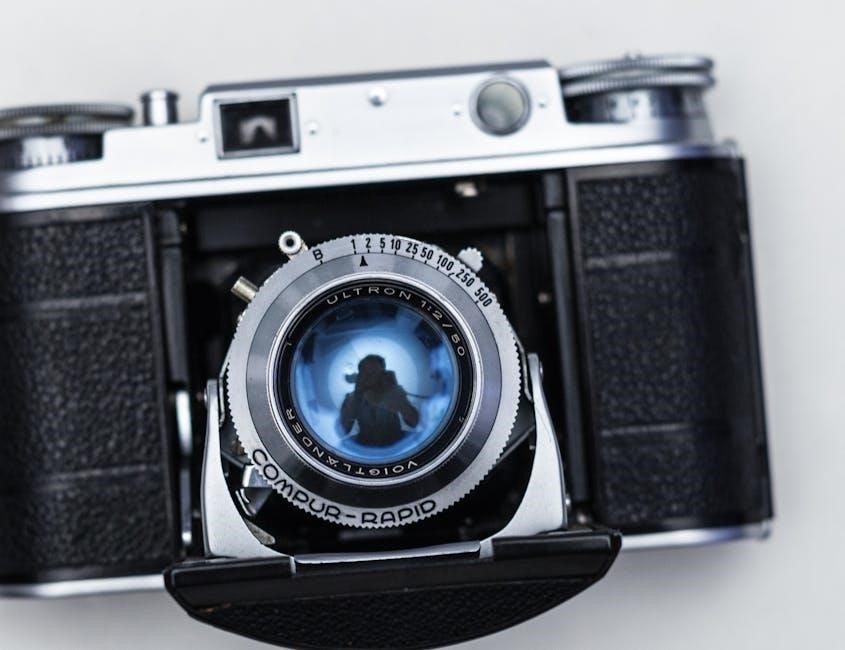
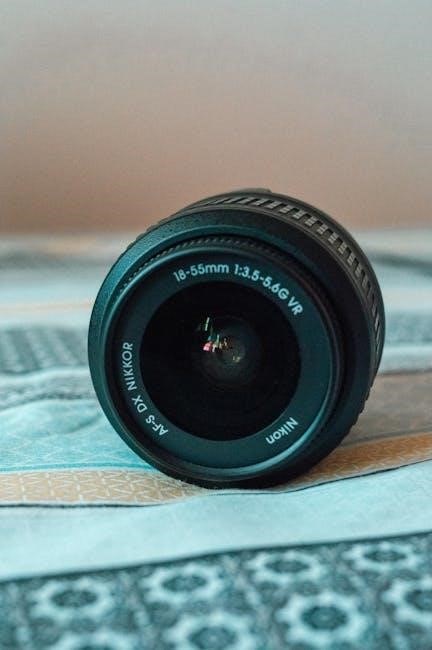
Advanced Shooting Techniques
Master advanced methods like depth of field control, long exposures, and flash photography to elevate your photography. These techniques enhance creativity and capture stunning images effectively.
Mastering Depth of Field
Depth of field (DoF) controls the focus area in your images, separating subjects from backgrounds. Aperture is key: smaller f-stops (e.g., f/2.8) create shallow DoF, blurring backgrounds, while larger f-stops (e.g., f/16) keep more in focus. Use the Nikon F’s aperture ring to adjust settings precisely. For portraits, wide apertures isolate subjects; for landscapes, narrow apertures ensure sharpness throughout. Practice with different lenses and lighting conditions to master this fundamental technique for creative control over your compositions.
Using the Nikon F for Long Exposures
Long exposures capture stunning effects like light trails or starry skies. Set the Nikon F to “B” or “T” mode for bulb exposures, allowing manual control over exposure time. Use a tripod to prevent camera shake. Start with shorter exposures (e.g., 30 seconds) and adjust based on results. For brighter conditions, use neutral density (ND) filters to extend exposure times without overexposing. Experiment with different durations to achieve desired artistic effects, making long exposures a creative tool in your photography arsenal.
Flash Photography with the Nikon F
Flash photography enhances low-light scenes and adds drama. Attach compatible flash units like the Nikon Speedlight to the hot shoe. Set the shutter speed to the flash sync speed (1/125s or slower). Adjust flash intensity manually for balanced exposure. Experiment with multiple flashes for creative lighting effects. Ensure the flash is synchronized correctly to avoid overexposure. Use the flash for fill lighting in bright conditions or to freeze action in low light, making it a versatile tool for dynamic photography with the Nikon F.
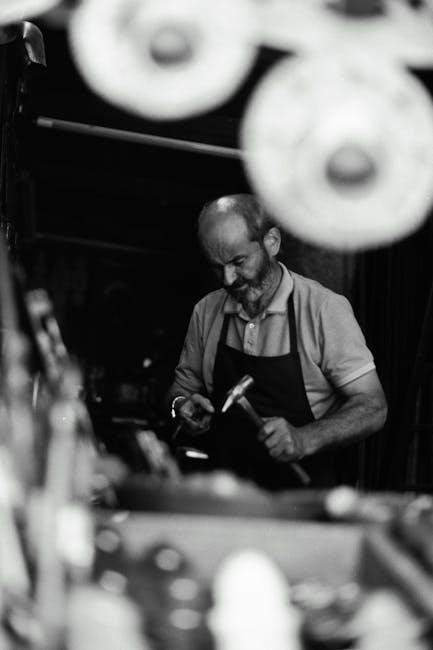
Understanding the Manual
Mastering the Nikon F manual is essential for optimizing camera performance. It provides detailed guidance on operations, features, and troubleshooting, ensuring photographers can fully utilize its capabilities.
How to Read the Nikon F Manual
Reading the Nikon F manual effectively requires a systematic approach. Start by familiarizing yourself with the table of contents to understand the layout. Focus on highlighted sections for key functions like film loading and exposure settings. Pay attention to diagrams and illustrations, as they provide visual guidance. Use the index to quickly locate specific topics. Refer to the troubleshooting section for common issues. Practice the techniques described to reinforce your understanding. By following these steps, you’ll master the Nikon F’s operations and unlock its full potential.
Common Photographic Terminology
Understanding key photographic terms is essential for mastering the Nikon F. Aperture refers to the lens opening, controlling light entry. Shutter speed is the time the shutter remains open, affecting motion capture. ISO indicates film sensitivity to light. Depth of field determines the focus area in an image. Exposure is the balance of aperture, shutter speed, and ISO. Familiarize yourself with these terms to optimize your photography with the Nikon F. Clear understanding enhances your ability to use the manual effectively and achieve desired results in various shooting conditions.
Where to Find Additional Resources
For deeper understanding, explore official Nikon resources, including the Nikon F manual PDF available on Nikon’s website. Photography forums like DPReview and Nikonians offer extensive discussions and tips. YouTube channels such as Tony Northrup and Peter McKinnon provide detailed tutorials. Additionally, photography courses on Udemy and Skillshare cover vintage cameras like the Nikon F. Local camera clubs and workshops are great for hands-on learning. These resources complement the manual, helping you master the Nikon F’s capabilities and enhance your photography skills effectively.
The Nikon F manual is a comprehensive guide to mastering a legendary camera. Its detailed instructions and timeless photography principles ensure continued relevance for photographers seeking precision and creativity.
The Legacy of the Nikon F
The Nikon F, introduced in 1959, revolutionized photography by popularizing the 35mm SLR format. Its durability, reliability, and interchangeable lenses set a new standard, making it a favorite among professionals. The F’s modular design and robust construction earned it a reputation for withstanding harsh conditions, cementing its place in photojournalism and wildlife photography. Its legacy endures as a symbol of innovation, influencing generations of photographers and camera designs. Collectors and enthusiasts still admire its timeless appeal, while its impact on photography remains unparalleled, shaping the course of imaging history.
Practical Tips for Getting the Most Out of the Nikon F
To maximize your Nikon F experience, always load film in low-light conditions to prevent exposure. Use a tripod for sharp images, especially in low-light settings. Experiment with different shutter speeds and apertures to master manual control. Regularly clean the lens and mirror to ensure optimal image quality. Practice focusing techniques for precise results. Familiarize yourself with the self-timer for steady shots. Shoot with fast lenses for better low-light performance. Keep the camera dry to avoid damage. Lastly, experiment with various films to explore unique aesthetics.
Final Words on Mastering the Nikon F Manual
Mastery of the Nikon F manual requires patience and practice. Understand its mechanics to unlock its full potential. Regular use and experimentation will deepen your familiarity with its controls. Keep the manual handy as a reference for complex techniques. The Nikon F’s durability ensures it will remain a reliable companion for years; By mastering this iconic camera, you join a legacy of photographers who value precision and craftsmanship. Embrace the process, and let the Nikon F become an extension of your creative vision.
